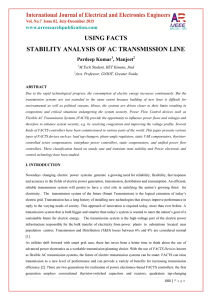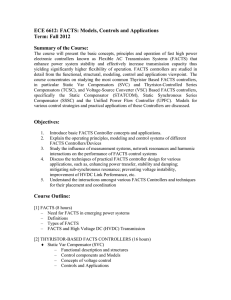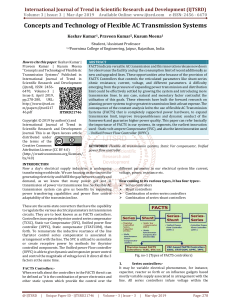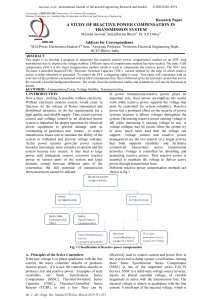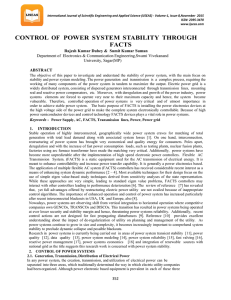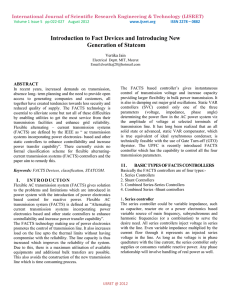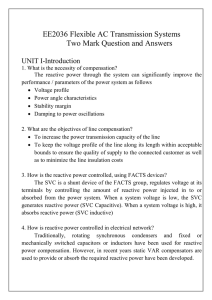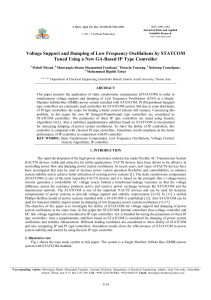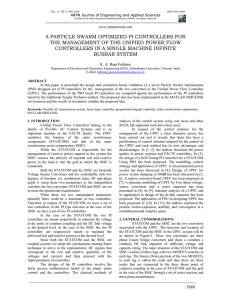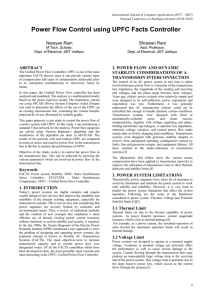Stability Analysis of AC Transmission Line Using FACTS
advertisement
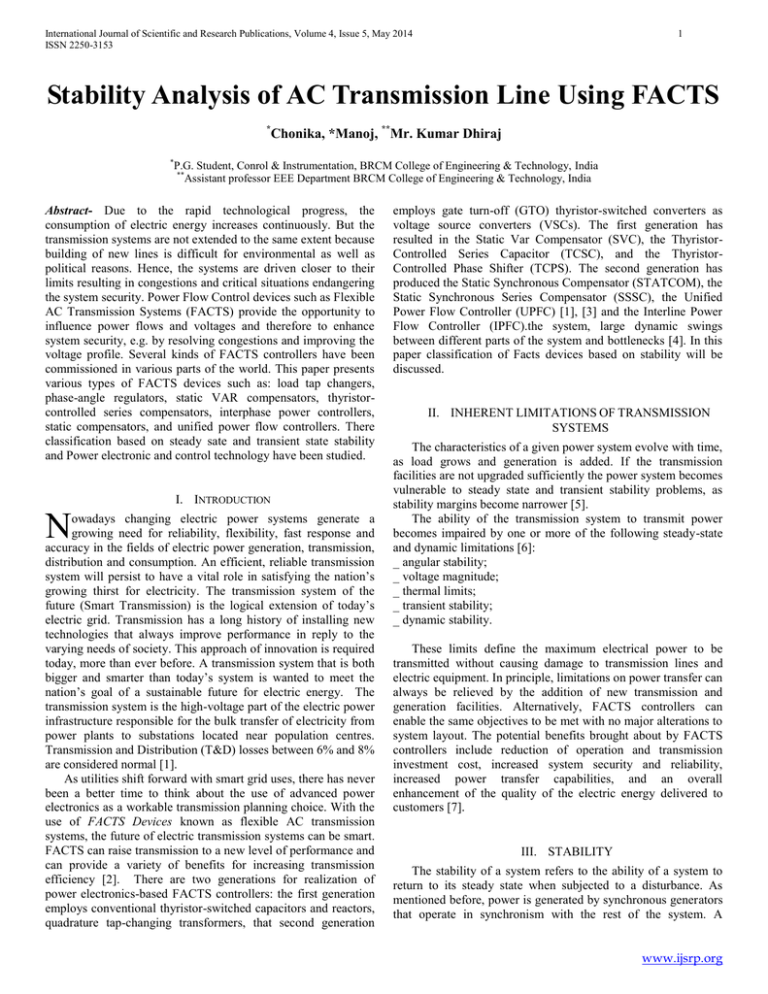
International Journal of Scientific and Research Publications, Volume 4, Issue 5, May 2014 ISSN 2250-3153 1 Stability Analysis of AC Transmission Line Using FACTS * Chonika, *Manoj, **Mr. Kumar Dhiraj * P.G. Student, Conrol & Instrumentation, BRCM College of Engineering & Technology, India ** Assistant professor EEE Department BRCM College of Engineering & Technology, India Abstract- Due to the rapid technological progress, the consumption of electric energy increases continuously. But the transmission systems are not extended to the same extent because building of new lines is difficult for environmental as well as political reasons. Hence, the systems are driven closer to their limits resulting in congestions and critical situations endangering the system security. Power Flow Control devices such as Flexible AC Transmission Systems (FACTS) provide the opportunity to influence power flows and voltages and therefore to enhance system security, e.g. by resolving congestions and improving the voltage profile. Several kinds of FACTS controllers have been commissioned in various parts of the world. This paper presents various types of FACTS devices such as: load tap changers, phase-angle regulators, static VAR compensators, thyristorcontrolled series compensators, interphase power controllers, static compensators, and unified power flow controllers. There classification based on steady sate and transient state stability and Power electronic and control technology have been studied. I. INTRODUCTION N owadays changing electric power systems generate a growing need for reliability, flexibility, fast response and accuracy in the fields of electric power generation, transmission, distribution and consumption. An efficient, reliable transmission system will persist to have a vital role in satisfying the nation’s growing thirst for electricity. The transmission system of the future (Smart Transmission) is the logical extension of today’s electric grid. Transmission has a long history of installing new technologies that always improve performance in reply to the varying needs of society. This approach of innovation is required today, more than ever before. A transmission system that is both bigger and smarter than today’s system is wanted to meet the nation’s goal of a sustainable future for electric energy. The transmission system is the high-voltage part of the electric power infrastructure responsible for the bulk transfer of electricity from power plants to substations located near population centres. Transmission and Distribution (T&D) losses between 6% and 8% are considered normal [1]. As utilities shift forward with smart grid uses, there has never been a better time to think about the use of advanced power electronics as a workable transmission planning choice. With the use of FACTS Devices known as flexible AC transmission systems, the future of electric transmission systems can be smart. FACTS can raise transmission to a new level of performance and can provide a variety of benefits for increasing transmission efficiency [2]. There are two generations for realization of power electronics-based FACTS controllers: the first generation employs conventional thyristor-switched capacitors and reactors, quadrature tap-changing transformers, that second generation employs gate turn-off (GTO) thyristor-switched converters as voltage source converters (VSCs). The first generation has resulted in the Static Var Compensator (SVC), the ThyristorControlled Series Capacitor (TCSC), and the ThyristorControlled Phase Shifter (TCPS). The second generation has produced the Static Synchronous Compensator (STATCOM), the Static Synchronous Series Compensator (SSSC), the Unified Power Flow Controller (UPFC) [1], [3] and the Interline Power Flow Controller (IPFC).the system, large dynamic swings between different parts of the system and bottlenecks [4]. In this paper classification of Facts devices based on stability will be discussed. II. INHERENT LIMITATIONS OF TRANSMISSION SYSTEMS The characteristics of a given power system evolve with time, as load grows and generation is added. If the transmission facilities are not upgraded sufficiently the power system becomes vulnerable to steady state and transient stability problems, as stability margins become narrower [5]. The ability of the transmission system to transmit power becomes impaired by one or more of the following steady-state and dynamic limitations [6]: _ angular stability; _ voltage magnitude; _ thermal limits; _ transient stability; _ dynamic stability. These limits define the maximum electrical power to be transmitted without causing damage to transmission lines and electric equipment. In principle, limitations on power transfer can always be relieved by the addition of new transmission and generation facilities. Alternatively, FACTS controllers can enable the same objectives to be met with no major alterations to system layout. The potential benefits brought about by FACTS controllers include reduction of operation and transmission investment cost, increased system security and reliability, increased power transfer capabilities, and an overall enhancement of the quality of the electric energy delivered to customers [7]. III. STABILITY The stability of a system refers to the ability of a system to return to its steady state when subjected to a disturbance. As mentioned before, power is generated by synchronous generators that operate in synchronism with the rest of the system. A www.ijsrp.org International Journal of Scientific and Research Publications, Volume 4, Issue 5, May 2014 ISSN 2250-3153 generator is synchronized with a bus when both of them have same frequency, voltage and phase sequence. We can thus define the power system stability as the ability of the power system to return to steady state without losing synchronism. Usually power system stability is categorized into Steady State, Transient and Dynamic Stability a) Steady State Stability studies are restricted to small and gradual changes in the system operating conditions. In this we basically concentrate on restricting the bus voltages close to their nominal values. We also ensure that phase angles between two buses are not too large and check for the overloading of the power equipment and transmission lines. These checks are usually done using power flow studies. b) Transient Stability involves the study of the power system following a major disturbance. Following a large disturbance the synchronous alternator the machine power (load) angle changes due to sudden acceleration of the rotor shaft. The objective of the transient stability study is to ascertain whether the load angle returns to a steady value following the clearance of the disturbance c) The ability of a power system to maintain stability under continuous small disturbances is investigated under the name of Dynamic Stability (also known as small-signal stability). These small disturbances occur due random fluctuations in loads and generation levels. In an interconnected power system, these random variations can lead catastrophic failure as this may force the rotor angle to increase steadily. 2 Fig. 1 Schematic Diagram Of The Thyristor Controlled Phase Shifter Load tap changer (LTC): This may be considered to be a FACTS controller if the tap changes are controlled by thyristor switches. IV. FACTS CONTROLLERS Power flow control has traditionally relied on generator control, voltage regulation by means of tap-changing and phaseshifting transformers, and reactive power plant compensation switching. Phase-shifting transformers have been used for the purpose of regulating active power in alternating current (AC) transmission networks. A number of FACTS controllers have been commissioned. Most of them perform a useful role during both steady-state and transient operation, but some are specifically designed to operate only under transient conditions. FACTS controllers intended for steady-state operation are as follows: Thyristor-controlled phase shifter (PS): This controller is an electronic phase-shifting transformer adjusted by thyristor switches to provide a rapidly varying phase angle. Figure 1 shows the schematic diagram of the Thyristor Controlled Phase Shifter (TCPS). The series transformer injects the voltage in series in the system. The active and reactive power injected by the series transformer is taken from the shunt transformer. For sake simplicity of analysis, the insignificant losses from transformer and converter is neglected. Thus the net complex power (real and reactive power) exchange between the TCPS and the system is zero. The injection of this complex power depends on the injection of a series voltage controlled by a converter. Fig. 2 Load Tap Changer Thyristor-controlled reactor (TCR): This is a shunt-connected, thyristor-controlled reactor, the effective reactance of which is varied in a continuous manner by partial conduction control of the thyristor valve. A thyristor controlled reactor is usually a three-phase assembly, normally connnected in a delta arrangement to provide partial cancellation of Harmonics. Often the main TCR reactor is split into two halves, with the thyristor valve connected between the two halves. This protects the vulnerable thyristor valve from damage due to flashovers, lightning strikes etc. www.ijsrp.org International Journal of Scientific and Research Publications, Volume 4, Issue 5, May 2014 ISSN 2250-3153 3 Fig. 3 Circuit Diagram Of Thyristor-Controlled Reactor Thyristor-controlled series capacitor (TCSC): This controller consists of a series capacitor paralleled by a thyristor-controlled reactor in order to provide smooth variable series compensation. Static compensator (STATCOM): this is a solid-state synchronous condenser connected in shunt with the AC system. The output current is adjusted to control either the nodal voltage magnitude or the reactive power injected at the bus. Solid-state series controller (SSSC): this controller is similar to the STATCOM but it is connected in series with the AC system. The output current is adjusted to control either the nodal voltage magnitude or the reactive power injected at one of the terminals of the series-connected transformer. Unified power flow controller (UPFC): this consists of a static synchronous series compensator (SSSC) and a STATCOM, connected in such a way that they share a common DC capacitor. The UPFC, by means of an angularly unconstrained, series voltage injection, is able to control, concurrently or selectively, the transmission line impedance, the nodal voltage magnitude, and the active and reactive power flow through it. It may also provide independently controllable shunt reactive compensation. Fig. 4 Simple Diagram of TCSC Interphase power controller (IPC): This is a series-connected controller comprising two parallel branches, one inductive and one capacitive, subjected to separate phase-shifted voltage magnitudes. Active power control is set by independent or coordinated adjustment of the two phase-shifting sources and the two variable reactances. Reactive power control is independent of active power. Fig. 5 The Schematic diagram of UPFC Power electronic and control technology have been applied to electric power systems for several decades. HVDC links and static VAR compensators are mature pieces of technology: Static VAR compensator (SVC): This is a shunt-connected static source or sink of reactive power. Fig. 4 Generic single-line diagram of the interphase power controller. ᴪ1, ᴪ 2 - Internal phase shifts XC - Capacitive reactance XL - Inductive reactance www.ijsrp.org International Journal of Scientific and Research Publications, Volume 4, Issue 5, May 2014 ISSN 2250-3153 4 system limits, FACTS provides the most reliable and efficient solution. The high initial cost has been the barrier to its deployment, which highlight the need to device proper tools and methods for quantifying the benefits that can be derived from use of FACTS. REFERENCES Gyugyi L, “Unified Power Flow Control concept for flexible transmission system”, IEE proceedings-C, pp 323 – 331, and Volume: 139, Jul 1992 [2] Engr.Qazi Waqar Ali et al. “ Smart Power Transmission System Using FACTS Device” International Journal of Engineering & Computer Science IJECS-IJENS Vol:12 No:06 14 121706-9393-IJECS-IJENS ©December 2012 IJENS I J E N S [3] N G Hingorani, L Gyugyi, “Understanding FACTS: Concepts and technology of flexible AC transmission systems”, IEEE Press; pp 432, 2000. [4] N G Hingorani, “FACTS-Flexible AC Transmission System”, Proceedings of 5th International Conference on AC and DC Power Transmission-IEE Conference Publication pp 1-7,Sep 1991 [5] Hingorani, N.G., Gyugyi, L., 2000 Understanding FACTS Concepts and Technology of Flexible AC Transmission Systems, Institute of Electrical and Electronic Engineers, New York. [6] Song, Y.H., Johns, A.T., 1999, Flexible AC Transmission Systems (FACTS), Institution of Electrical Engineers, London. [7] IEEE/CIGRE´ (Institute of Electrical and Electronic Engineers/Conseil International des Grands Re´seaux Electriques), 1995, FACTS Overview, special issue, 95TP108, IEEE Service Centre, Piscata-way, NJ. [8] “ A Robust Design of a St at ic VAR Compensat or Cont roller for Power System Stability Improvement ” by Hosseini and Mirshekhar, 2001 ISBN: 1-56555-268-7 [9] Ambriz-Pe´rez, H., 1998, Flexible AC Transmission Systems Modelling in Optimal Power Flows Using Newton’s Method, PhD thesis, Department of Electronics and Electrical Engineering, University of Glasgow, Glasgow. [10] Fuerte-Esquivel, C.R., 1997, Steady State Modelling and Analysis of Flexible AC Transmission Systems, PhD thesis, Department of Electronics and Electrical Engineering, University of Glasgow, Glasgow. [11] Pratik Biswas, “The Influence of Thyristor Controlled Phase Shifting Transformer on Balance Fault Analysis”, International Journal of Modern Engineering Research (IJMER) www.ijmer.com Vol.2, Issue.4, July-Aug. 2012 pp-2472-2476 ISSN: 2249-6645 [1] Fig. 6 SVC connected to a transmission line. High-voltage direct-current (HVDC) link: This is a controller comprising a rectifier station and an inverter station, joined either back-to-back or through a DC cable. The converters can use either conventional thyristors or the new generation of semiconductor devices such as gate turnoff thyristors (GTOs) or insulated gate bipolar transistors (IGBTs). V. RESULT AND CONCLUSION In order to assist power system engineers to assess the impact of FACTS equipment on transmission system performance, it has become necessary to write new power system software or to upgrade existing software. This has called for the development of a new generation of mathematical models for transmission systems and FACTS controllers, which had to be blended together, coded, and extensively verified. This has been an area of intense research activity, which has given rise to a copious volume of publications. Many aspects of FACTS modelling and simulation have reached maturity, and we believe that the time is ripe for such an important and large volume of information to be put together in a coherent and systematic fashion. With the history of more than three decades and widespread research and development, FACTS controllers are now considered a proven and mature technology. The operational flexibility and controllability that FACTS has to offer will be one of the most important tools for the system operator in the changing utility environment. In view of the various power AUTHORS First Author – Chonika, P.G. Student, Conrol & Instrumentation, BRCM College of Engineering & Technology, India Second Author – Manoj, P.G. Student, Conrol & Instrumentation, BRCM College of Engineering & Technology, India Third Author – Mr. Kumar Dhiraj, Assistant professor EEE Department BRCM College of Engineering & Technology, India www.ijsrp.org
